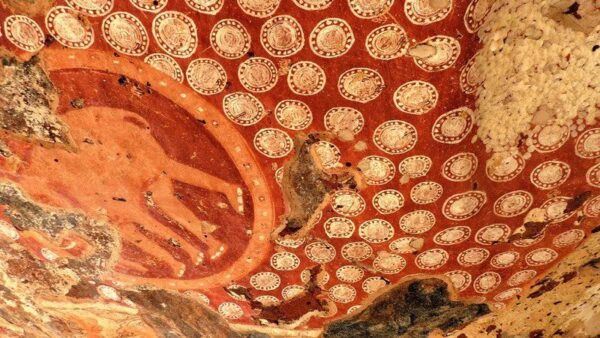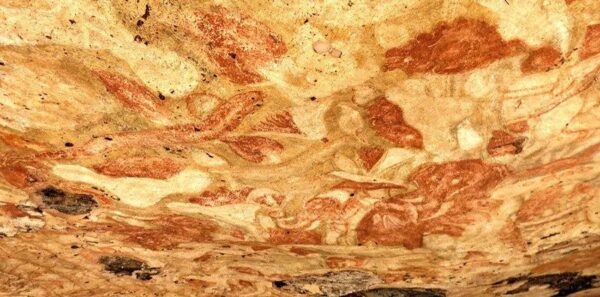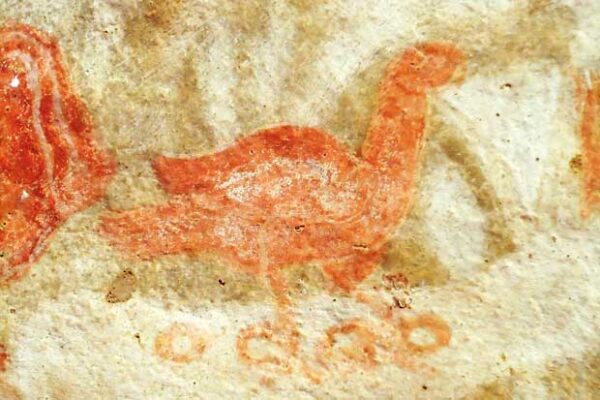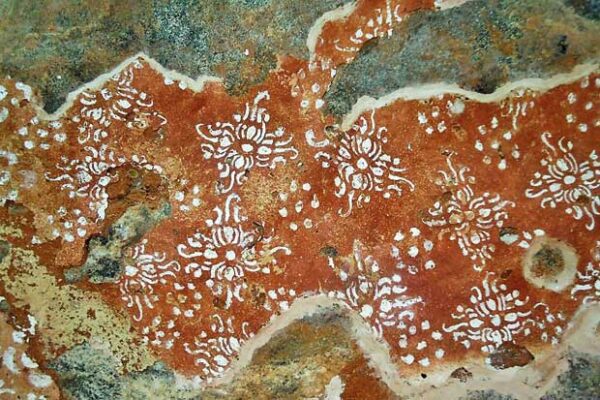Pre-historic cave murals in Kotiyagala
By Arundathie Abeysinghe
 Located approximately 45 kilometers from *Monaragala in close proximity to *Lahugala and *Yala National Parks, Mailla (also known as Miyella) in Kotiyagala, (the area is famous for wild elephants and bears), the ancient Temple can be accessed through an arduous journey of six kilometers in a jungle area. The location is well-known for the Mailla cave.
Located approximately 45 kilometers from *Monaragala in close proximity to *Lahugala and *Yala National Parks, Mailla (also known as Miyella) in Kotiyagala, (the area is famous for wild elephants and bears), the ancient Temple can be accessed through an arduous journey of six kilometers in a jungle area. The location is well-known for the Mailla cave.
According to sources, this site had been discovered by a group of surveyors in 1966. In 1967, an Italian Archaeologist who arrived in Sri Lanka to restore *Sigiriya Frescoes had visited these caves and restored some murals. Yet, there is no evidence of any local authority intervening in to restore these cave murals, according to locals.
Encompassing an area of several hectares from the slopes of Mailla Mountain, there are several caves in the locality including drip ledge caves, a reclining Buddha Statue 27 feet (approximately 8.2 meters) made of brick and clay damaged by treasure hunters. Later, the vandalized statue had been retouched.
According to scholars, the cave murals date to historic as well as pre-historic era and the murals are in a state of destruction and are perishing due to lack of maintenance as well as constant exposure to elements.

Archaeologists consider the cave murals as dating to pre-historic era, whereas the ancient temple dates to *Kandyan era.
According to historical records, the cave shrine has evolved into a Buddhist hermitage between 4th and 5th Century.
There are also drawings on the rock walls believed to have been drawn by *Veddas. There are also several images of damsels with flower motifs painted on the rock ceiling. There are exquisite floral designs among the paintings, although different, yet similar to Sigiriya frescoes. The maidens are painted mostly in red and provide a stark contrast to the white background. Among the paintings, there are also several paintings of elephants with one engaged in water sports, another carrying a lotus in its trunk and the third on the verge of escaping from the scene. Archeologists are of the view that one of the murals depicting a human figure mounted on a mammal similar to an elephant may be attributed as belonging to the pre-historic era, yet it is difficult to arrive at a date or period due to lack of historical records.
Entrance to Mailla cave complex is through the main cave and the main entrance leads to a cluster of caves. According to scholars, some caves in the Cave Complex have been occupied by ascetic monks in the past. The drip ledge caves as well as the Buddha Statue indicate that there had been a Buddhist Temple in the area, a concept confirmed by archaeologists.
According to historians, Mailla cave is one of the ancient art repositories in Sri Lanka, offering a glimpse of aesthetic creativity of a bygone era.
There had also been a stupa (dagoba) enshrined with relics on the rock boulder which had been destroyed. At present, there is a flat heap of rubble overgrown with weed.

During the past few decades, due to deforestation and *chena cultivation, the forest has been cleared and the caves have been exposed to extreme weather conditions. As a result, priceless artefacts including paintings and clay statues have been destroyed.
According to archaeological authorities, the ancient temple, cave murals and its environs have not received any attention from relevant authorities…
Image courtesy – dailymirror.lk

- Chena cultivation – This is a traditional form of cultivation which extends as far as 5000 years, the oldest form of faming in Sri Lanka. In the past, each village had a chena. Vegetables, cereals as well as green leaves are cultivated in a chena.
- Kandyan Era – Kandyan period is from 1597-1815, the last independent monarchy of Sri Lanka. Kandyan Kingdom was located in the central region of Sri Lanka. The Kingdom was independent from Portuguese and Dutch rule. Later, the Kingdom was colonized by the British in 1815.
- Lahugala Kitulana National Park – Sri Lanka’s smallest national park, situated in close proximity to Arugam Bay (regarded as the best surfing spot in Sri Lanka) on the east coast. Despite its land area, the Park is a significant habitat for Sri Lankan elephant (Elephas maximus maximus) and endemic birds of Sri Lanka.
- Sigiriya Frescoes – Painted on the western surface of Sigiriya Rock (an ancient rock fortress located in Matale District in the Central Province, Sri Lanka). Painted thirteen hundred years ago, these frescoes were the highlight of an enormous palace complex. According to some scholars, the painted damsels are celestial nymphs carrying flowers to shower upon kings and mortals. Others suggest that they are queens and concubines of King Kasyapa’s (473- 495 CE) harem.
- Monaragala – Located in *Uva Province, Monaragala is the largest town in Monaragala District.
- Uva Province – Fourth largest province in Sri Lanka bordered by Central, Eastern and Southern provinces.
- Veddas – Also spelled Veddahs and known as “Wanniyalaeto” are a minority indigenous group of people in Sri Lanka. Considered as Sri Lanka’s aboriginal inhabitants prior to the 6th century bce, according to historical records, they were the children or descendants of Queen Kuweni, a Yaksha tribe (Demon) and wife of Sri Lanka’s legendary first King Wijaya (5th century BC). Anthropologists have dated them to the stone age. Predominantly, hunter-gather people, the Veddas have been living harmoniously with nature.
- Yala National Park – Located in the south eastern region of Sri Lanka and extending over Monaragala District in Uva Province and Hambantota District of Southern Province, the Park gives visitors the best opportunity to witness Sri Lanka’s broad variety of wildlife ranging from colorful painted storks, lovely fantailed peacocks in their resplendent blues and greens, the elephants crossing the tracks and wandering off into the thorny scrub jungle and the star attraction of the Park, the elusive leopard (Panthera pardus kotiya) lounging on mammoth granite boulders that dot the Park.








